The information on this page is outdated. Please go to the home page and refresh it.
Geological excursion
Geological structure and mineralization distribution
Formation of modern geological structure of the area happened thanks to a collision of the Siberian and Kazakhstan continental blocks with which closing of the small oceanic pool dividing them came to the end. Nature of movement of continental masses caused formation of subparallel structural zones of the northwest spread direction divided by deep breaks (fig. 1).
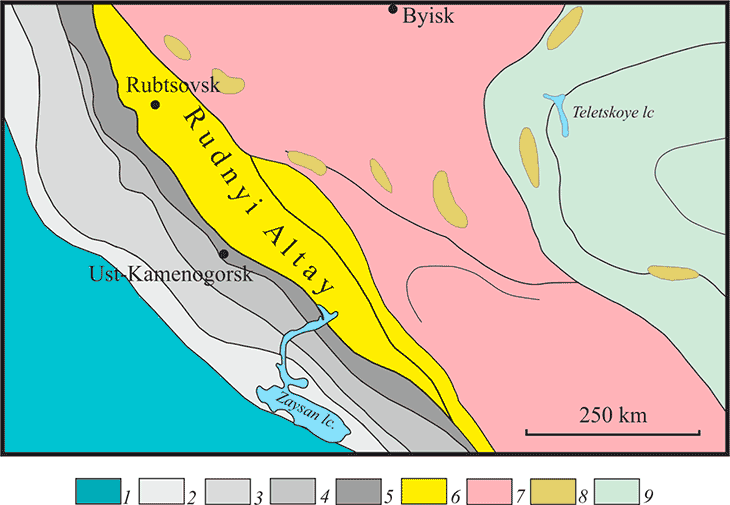
Fig. 1. The scheme of modern placement of structural and material complexes and structural zones of active and suburban and continental (D1-C1) and conflict stages of development of the western part of Altai-Sayansk folded area and Irtysh Zaysanskoy of folded system of Ob-Zaysansky folded area (on State …, 2011а) with additions of authors.
Symbols: 1 – Island-arc and accretion complexes of margin of the Kazakhstan continent, 2 – the Charsko-Zimunaysky suture zone created at closing of the PaleoAsian ocean; 3 – terrigenous complexes of the residual sea pool after a collision of continents (A West Kalba zone); 4 – sedimentary complexes of a slope of a deep-water trench (the Kalba-Narymsky block); 5 – complexes of a sedimentary terrace and accretion prism over a subduction zone (An Irtysh collapse zone); 6 – frontal zone of a Devonian active and suburban and continental vulcano-plutonic belt (Ore Altai); 7 – axial zone of a Devonian vulcano-plutonic belt (the western and central parts of Mountain Altai, Salair), 8 – manifestations of an average and late Devonian volcanism in axial and rear zones of the active margin ; 9 – zone rear рифтов active continental margin (Western Sayan Mountains).
Areas the richest concerning an ore mineralization are dated mainly for the Ore-Altai structural and formational zone and the Salairo-altaysky megablock divided by the Northwest collapse zone.
Ore-Altai SFZ and related orudeneniye
The ore-Altai structural and formational zone is put by the formations answering to situations of the active continental suburb which started developing in early Devon from a laid under structures of Ore Altai hollow the inclined zone of a subduktion (State. 2001). According to authors of this geological card in after-emssky time on the edge of the Siberian continent the extended volcanic-plutonic belt possessing many characteristic features of the active continental suburb of the Andi type developed. Thus, the frontal part of this belt (modern Ore Altai) could represent an ensimatic segment of the active suburb of the continent with formation of volcanic deflections of riftogenic type (the active continental suburb of the Californian type) or the active continental suburb of Nevada type combining signs of mature the ensialic of island arches and active continental suburbs.
In the Ore-Altai structural and formational zone in the conditions of a frontal arch in intermountain deflections volcanic-sedimentary multicoloured molasse strata with volcanics rhyolitic and basalt-andesite-rhyolitic, and in more southern areas and andezitovy formations were formed. Volcanic activity was accompanied by introduction of a large number small and large subvolcanic and the hypabyssal massifs of a gabbro-tonalite-plagiogranites of aleysky and gabbro-granite-light granites of zmeinogorsky of complexes (fig. 2).
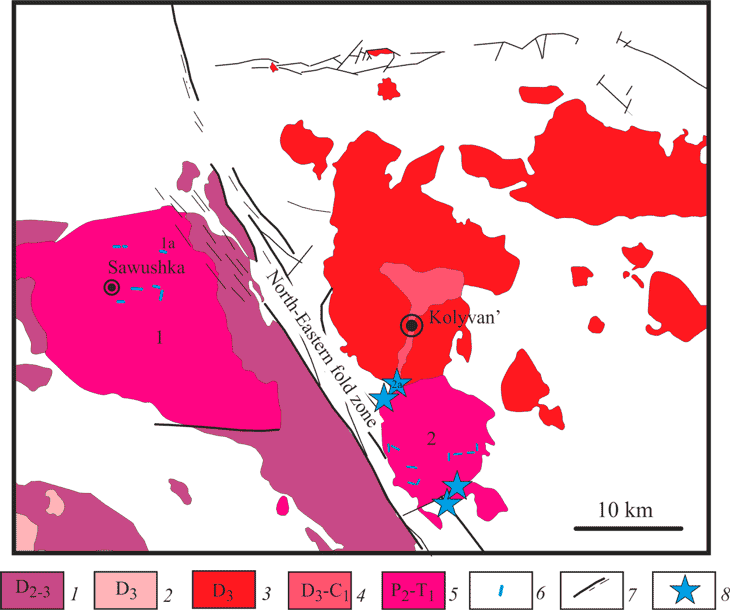
Fig. 2. The scheme of placement of intrusive magmatic complexes around carrying out excursion.
Symbols: 1 – aleysky gabbro-plagiogranites; 2 – zmeinogorsky gabbro-granite-light granites; 3 – ust-belovsky gabbro-diorite-granodiorites; 4 – borovlyansky granodiorite-granite; 5 – sinyushinsky granodiorite-granite-light granites; 6 – veins and dike of granite pegmatites and applets; 7 – explosive violations; 8 – manifestations of a rare-metals mineralization. Massifs: 1 – Savvushinsky, 2 – Sinyushinsky. Objects of excursion: 1а – the Savvushinsky pegmatites field, 2а – Kolyvanskoye W-Cu-Bi a field.
Possibly, the Devonian volcanism had a certain recurrence that basalt - a rhyolitic zhivetsko-fransky volcanism is fixed by change significantly riolitoidny explosive with игнимбритами early среднедевонского a volcanism. The following famensky cycle of a subaeralny volcanism is shown in the territory of adjacent Kazakhstan and is characterized by prevalence of andesites over basalts and sour derivatives (Big Altai …, 1998). The periods of decrease in volcanic activity (magmatic pauses) between cycles were fixed by accumulation of deposits sea gray-colored and continental multicoloured terrigenous вулканомиктовых the molasse formations.
Throughout development of the active continental margin on the average – late Devon intensive tectonic and hydrotermal-metasomatic processes with formation of numerous fields and manifestations polymetallic, barite - polymetallic and the pyrites ores with gold and silver proceeded. These fields belong to the stratiform coat type. The arrangement and stratigrafichesky confinement of fields of this type is defined by development of explosive violations and an arrangement of volcanic apparatus.
Formation of the main ore fields within Ore Altai happened during all history of development of Devonian vulсano-plutonic belts, however most intensively these processes proceeded on the Middle Devon and on border of Middle and Late Devon.
On the Russian part of the Ore-Altai polymetallic belt as the most productive, are allocated three temporary levels: Early-Middle Devon (Ems-eyfel) of zmeinogorskiya, Middle Devon (zhivetsky) zolotushinskiya and Late Devon (franskiya) Rubtsovsk-Talovsky.
Formation of fields of a gold silver-barite-polymetallic subformation (Zmeinogorsky field) is connected with an early zmeinogorsky stage, copper колчеданной and, to a lesser extent, a polymetallic subformation. With late Rubtsovsk-Talovsky the stage connected formation of fields of the Rubtsovsk ore area (The Rubtsovsk, Talovsky and Steppe fields), relating to a pyrite-polymetallic formation.
Formation of ores happened at the final stages of a volcanism and in connection with introduction of subvolcanic intrusions of sour structure. Formation of ores took place a hydrotermal-metasomatic way in near-surface conditions during active manifestation of hydrothermal processes on slopes paleovolcanoes, at the bottom of water pools among deposits of intermediate and remote volcanic facies over being formed subvolcanic massifs rhyolites-like. On the mechanism of education and the main factors of an ore deposition of a field of a pyrite-polymetallic formation are subdivided into two structural types: consonant or stratiform (coat type) and a secant, vein-veined, present both in common with stratiform, and it is independent. In ores the steady mineral structure is noted. Ore deposits of fields accompany auras of hydrotermal-metasomatic breeds sericite - quartz, sericite - chlorite, chlorite - carbonate, talc - carbonate is more rare than structures. Ores are characterized by a certain set of elements impurity (Cd, Ag, Bi, Mn, As, Sb) and the steady isotope composition of native sulfur close to meteoric that testifies to a stable significantly deep source of sulfur.
History of intrusive magmatism of the region and mineralization of the Salairo-Altaysky megablock
The magmatic history of the area began in Early Devon from the beginning of development of the active margin of the Siberian continent. Introduction is connected with development of a vulkano-plutonic belt of the Ore-Altai structural and formational zone in its limits late Devonian intrusions, relating to a gabbro-tonalite-plagiogranites aleysky and gabbro-granite-light granites to zmeinogorsky complexes.
In late Devon there is a new flash of a volcanism to which answer subaerial effusives, sub volcanic bodies and tefroidy, according to some researchers (Rotarash, etc., 1982) representing an island volcanic arch. Introduction falls on this time within the Salairo-Altaysky megablock the mesoabyssal of I-granites of ust-belovsky (a gabbro-diorite-granodiorites a formation of Late Devon) and borovlyansky S-granites (a garnodiorit-granite formation of late Devon - Early Carbon formation) complexes (fig. 2). With this stage of magmatism emergence of gold deposits (the Murzinsky field), and also a row gold-silver is connected with polymetals fields and manifestations.
Completion of development of a vulcanic-plutonic belt of Ore Altai happens in Early Carboniferous. From this moment on the collision stage of development of northwest part of Altai begins. It includes a long period of time with the Early Carboniferous to the Cretaceous after closing Paleo-Asian Ocean. In the early Perm time, in adjacent territories to the West of the Irtysh crumple zone, West Kalba and Kalba-Narymsky zones typical collision formation – large batholiths the Early Perm granite's formation of the kalbinsky complex, put by S-type granitoids are formed. Extensive manifestations are connected with these granitoids raremetal (Li, Be, Cs, Ta, Nb, Sn) mineralization at territories of East Kazakhstan.
Active collisions processes are shown with some attenuation proceeded to Early Perm, having replaced by a mode of a late-collision-riftogenic stage and a stage of epicollision stabilization. During these stages in the territory of the Salairo-Altaysky megablock magmatic intrusive massifs of sinyushinsky complex granodiorite-granite-light granites were created. With massifs of this complex manifestations of granite pegmatites with rare-earth (the Savvushkinsky pegmatitic field) and beryllium (the Tigereksky pegmatitic field) a mineralization, and also quartz and vein and greisen tungsten fields are connected with molybdenum in exocontact the Sinyushinsky massif.
Objects of geological excursion
Zmeinogorsky field (Au-Ag-Cu-Pb-Zn)
The Zmeinogorsky field of gold-silver-barite-polymetallic ores in the XVIII-XIX centuries is fulfilled completely up to the depth of 200 m regarding the top subband gold-silver-baryte mineralization with polymetals. In the 40-50th years of the XX century the bottom ore subband unknown earlier was revealed. Its structure is represented as a monocline northwest trending with the fall in the north-east at an angle of 40-50 º. It is complicated by the Main strike-shift fault of North North east trending limiting from the West an industrial mineralization. On a field after-ore steeply dipping dikes of dolerites of the sub-latitude and northeast trending are developed.
The endogenous ore zone of a field shares on the bottom, average and top subbands connected, respectively, with the bottom, average and top subsuites of mel'nichny suite (fig. 3). The bottom and average subbands are presented by polymetallic (copper and zinc-lead) ores, top (from below-up): polymetallic, gold silver-barite-polymetallic and barytes (Chekalin, 1996). The top subband, substantially bald-headed, is presented by a deposit of the Big rating and the small Komissky deposit separated on trending. It is characterized by industrial stocks of ores. Average – nonindustrial. Bottom can represent practical interest. On a field the exogenous ore zone in the form of three scatterings of gold known since 1935 was created also.
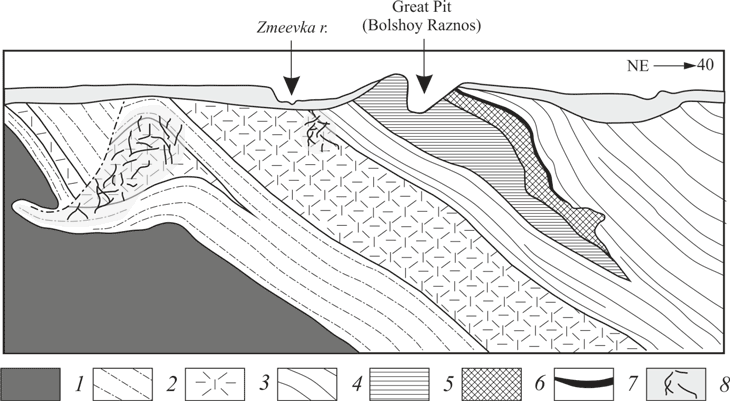
Fig. 3. Geological section of the Zmeinogorsky field (on State … 2001b).
Symbols: 1-friable sandy-argillaceous deposits of the Cenozoic, 2–4 – deposits of mel'nichny suite (D1-2):2 – aleurolites and mudstones limy and siliceous; 3 – tuffs and lavas of rhyolites and rhyodacites; 4 – aleurolites, sandstones, tuffs sour structure; 5 – metamorphic slates of the Paleozoic; 6–8 – ores of the top subband; 6 – the gold and polymetallic; 7 – the gold-silver-barite-polymetallic; 8 – the barytes; 9 – polymetallic vein mineralization-wire of average and bottom subbands.
Polymetallic mineralization vein and vein-disseminated, in the bottom subband the stockwork. Gold-polymetallic ore exclusively vein type quartz-barite-sulfide composition, associated with hydrothermal-sedimentary quartzites, in large upper part is exposed and can be traced along strike and 390 m (up to 100 m), with full pinch-out at a depth of 220 m. Gold-silver-barite-polymetallic ores (generally continuous) lie on gold and polymetallic ores, being traced along strike in the large separation on 220 m, at the power up to 20 m. At a depth of 210 m they wedge out. Baryte ores, lying on gold silver-barite-polymetallic, crown the top ore subband. Their power reached several meters.
Ores poor in all subareas: the content of Cu - 0,2-0,6, Pb - 1,2-1,52, Zn - 1,87-2,37%, Au - 0,1 and Ag - 8 -22 ppm; gold-polymetallic and gold-silver-barite-polymetallic: Cu - 0,17 and 1,2, Pb - 0,85 and 5,5, Zn - 1,64 and 7,08-8,3%, Au - 2.0 and 5.3 ppm, Ag - 29,0 and 435-680 ppm, respectively. Barite ores contain BaSO4 - 92,45-99,22%, as well as native gold up to 3-5 ppm
Gold-silver-barite-polymetallic and barite ore are worked. Unprocessed are polymetallic and gold-polymetallic ores, some of which may be the subject of future production.
Based on a geological structure of ore formations of the Zmeinogorsky field it is possible to assume that their formation reflects features of course of volcanic-hydrothermal processes in near-surface zones and in a surface. Formation of the main deposit of gold-silver-barite-polymetallic ores is possibly connected with sedimentation on a surface of a bottom of the sea pool. While vein and stockwork formation represent fragments of a mineralization of bringing channels of hydrothermal system.
Granite pegmatites of the Savvushinsky field
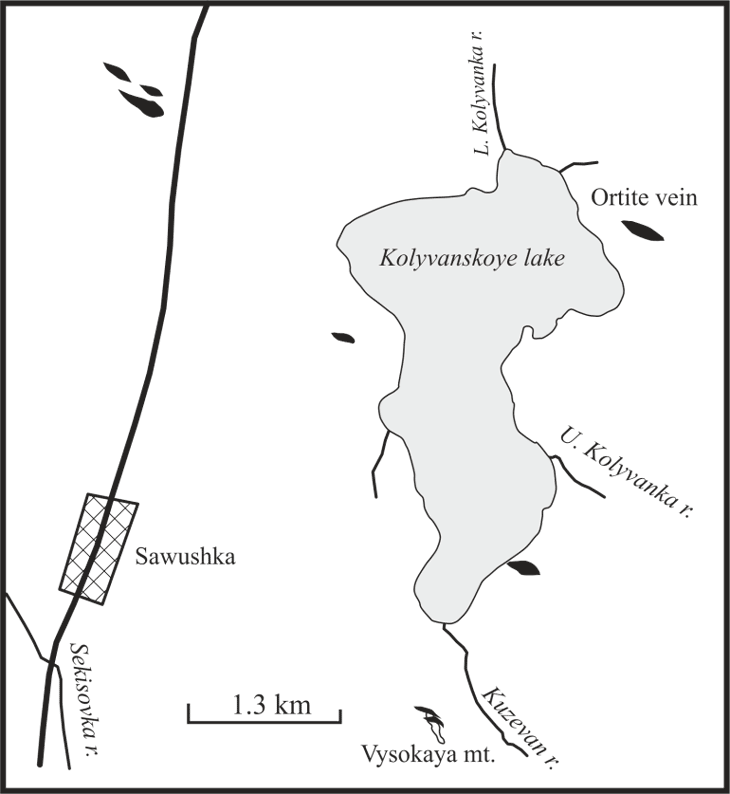
Fig. 4. The placement scheme the pegmatites
Savvushinsky pegmatite field.
Granite pegmatites of the Savvushinsky field are presented by a series of small veins of the sub-latitude strike (fig. 2, a field 1a), the lakes of Kolyvansky (fig. 4) developed in vicinities. Besides in apical part of the High mountain on the southern coast of the lake a series small the pegmatites of streaks, secants granites and schlieren, having with granites gradual transitions is found. The largest and interesting from the point of view of mineralogy is Orthite vein.
The Orthite vein is opened with a small pit (spacing) on the northern coast of the lake of Kolyvansky and represents the sub-latitude tabular body with power in the bulge about 5 m, plunging to the south. For it well expressed zonality is characteristic. External parts of a vein are put graphic quartz-feldspar by the pegmatite passing into a coarse-grained pegmatite with subordinated biotite. Power of this zone is insignificant and in separate sites reaches about 10 cm.
The main volume of a pegmatite the quartz-plagioclase-kalishpatovym by a pegmatite is put with block structure roughly and giant-grain. On east wall of a pit it is clearly visible what exactly to this zone, namely areas of development rough and a giant-grain pegmatite are dated large crystals of allanite (orthite) and titanite (fig. 5).
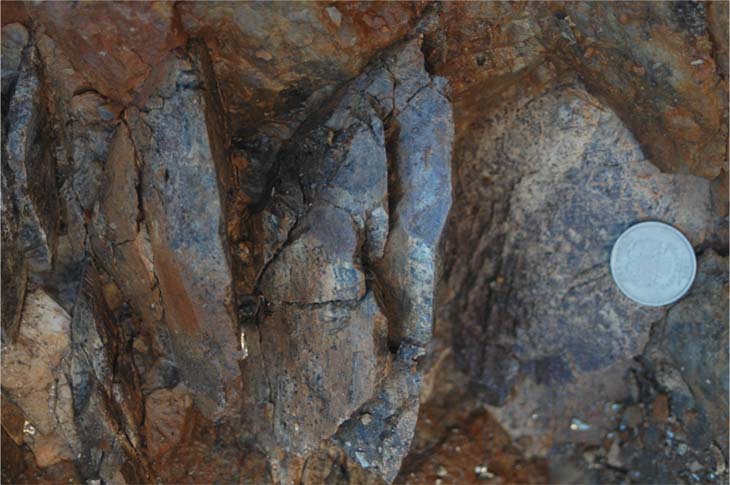
Fig. 5. Large crystals of sphene on border of block potassium feldspar and a quartz kernel.
In 80-90 years XX century in the top part of a pit the subvertical zone of the cracks containing druse natural of excrescence of well educated crystals of smoky quartz on blocks of potassium feldspar with graphic quartz ingrowths was opened. The zone had a subvertical tubular form and stretched down from a zone of a block pegmatite in a zone of a graphic pegmatite. Its education is connected with recrystallization processes the pegmatitic paragenesis by later pegmatitic fluid. Characteristic of this zone is quartz-feldspar composition of a druse's paragenesis.
Replacement of potassium feldspar with albite is distinctly shown in blocks. Replacement with albite happens on cracks to formation of white mica-albite of streaks. In some cracks natural fouling of blocks of pink potassium feldspar were found by white transparent albite. In association with albite of this stage greenish white mica and эпидот is formed. Muscovite-albite veins often contain small cavities filled by epidote. Sometimes in the diameter 10-15 centimeters can reach such cavities, which size, druzes of white mica and well-faceted smoky quartz crystals with vrostka translucent epidote contain. As rare finds in similar cavities crystals of apatite of turquoise color with a very rich faceted heads are found. In spite of the fact that white mica-albite with epidote a paragenesis, also as well as quartz-feldspar were created thanks to late pegmatitic fluids, their mutual ratios in a vein it isn't established. Most likely they were formed in the isolated systems of cracks under the influence of the fluids created in various parts of a pegmatitic body.
In a block zone of a pegmatite, in the central part of a vein almost monomineral allocations of gray quartz – quartz kernels are developed. The size of kernels can reach about 1 meter. On borders of quartz kernels and block potassium feldspar the associations replacing potassium feldspar are often developed cavernous white mica-albite.
Kolyvansky field
The Kolyvansky field known since 1721-1723 as copper, in 1936-1960 was fulfilled already as tungsten with copper and bismuth. Genetically belongs to pneumatolytic-hydrothermal-plutonic type of a quartz-vein formation. It lies in powerful (150-300 m) dyke-like submeridional vertically falling the teleaplite granites, breaking through grano-diorites of an ust-belovsky complex and cut off in the southern part porphyritic granites of a sinyushinsky complex. It is broken by tectonic violations sbroso-shift character into three blocks: Southern, Central, Northern. Each of blocks is presented by a series of quartz ore-bearing veins of submeridional stretch with a very steep, mostly western falling. From a set of veins industrial are 25. Their extent on stretch – 50-350 m, on falling – to 150-200 m. Often the size on falling exceeds that on stretch. Power of industrial veins, in most cases, - 0,2-0,7 m, in bulges reaches 1-2 m, rarely it is more.
Mineralized veins are bared in all blocks. Each of blocks differs level of an erosive cut, a form of manifestation of quartz veins, their quantity and the sizes, relationship with granites containing them, quantity of stocks, etc. In the Southern block of a vein of the smaller sizes, is more often than a lenticular, at meridional stretch fall in different directions, lie in reisenized granites. Central block differs the greatest number of industrial veins, their big sizes on falling, than on stretch, frequent раздувами, branches. The northern block is characterized by relative simplicity of a structure of veins.
Veins are put by gray quartz. near selvage parts borders of coarse-grained white mica of gray and greenish color are developed. In quartz large crystals of fluorite of light pink and green color come across. In the greisenized granites quartz-tourmaline nests often meet.
The main ore mineral – the wolframite which is showing in the form of a small impregnation in quartz and greisenized granites, less often it forms large nests of crystals. Wolframite crystals tabular and thin-plate, often form joints. Except wolframite in vein quartz arsenopyrite, pyrites, scheelite, chalcopyrite, bismuthine, molybdenite and sulfosalts of Bi meet also.
In the zone of oxidation falling up to the depth 25-30 m, hematite, limonite, covellite, chalcosine, cuprite, malachite, azurite and tungsten ochre are established.
Novofirsovsky gold field
Novofirsovsky field represents a field of fine-grained gold in weathering crusts. The field is in a private property. On it the modern complete technological chain on ore processing from production on career before metal smelting is put.
Literature
- Big Altai: (geology and metallogeny). In 3 books. Book. 1. Geological structure / Szczerba G.N., Diachkov B.A., Stuchevsky N.I., et.al., Almaty, Fylym, 1998. 304 p.
- State Geological Map of the Russian Federation of scale 1:200 000. Edition 2. Altaic Series. Sheet M-44-X (Miner). Explanatory memorandum. / Murzin O.V., Gorshechnikov V.I., Zhdanov V.A., et.al., St. Petersburg. VSEGEI, 2001a. 219 p.
- State Geological Map of the Russian Federation of scale 1:200 000. Edition 2. Altaic Series. Sheet M-44-XI (Zmeinogorsk). Explanatory memorandum. / Murzin O.V., Chekalin V.M. Syroezhko N.V., et.al. St. Petersburg., VSEGEI, 2001b. 174 p.
- Chekalin V.M. Geological-genetic features Rubtsovskoe deposit ores at Ore Altai // Ores and Metals, 2002, 1, 23-31 p.

 Rus
Rus